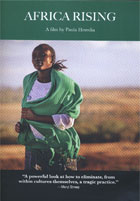
Africa Rising 2009
Distributed by Women Make Movies, 462 Broadway, New York, NY 10013; 212-925-0606
Produced by Paula Heredia
Directed by Paula Heredia
DVD, color, 62 min.
Sr. High - Adult
African Studies, Women's Studies, Health Sciences, Political Science, Activism, Female Circumcision
Date Entered: 10/21/2010
Reviewed by Bassey Irele, Widener Library, Harvard UniversityAfrica Rising takes us through Tanzania, Kenya, Somalia, Burkina Faso and Mali showing us how African activists are working hard in rural communities to have an age-old cultural practice eradicated. This practice has names as varied and complex as the explanations for its strong hold on some African communities - female circumcision (FC), female genital mutilation (FGM), female genital cutting (FGC), and female genital surgery (FGS).
The activists, working diligently to eliminate a firmly rooted practice seem undaunted by the challenges, and motivated by their concern for women’s health and human rights. We admire their sense of mission. We appreciate the way they skillfully deploy different strategies and resources towards the achievement of their goal. They hold group and individual conversations with parents, community elders, and religious leaders; they organize town hall sessions where they reinforce their message with illustrations on a chalkboard; and they set up safe havens for girls as in the Tasaru Rescue Centre (Somalia), Centre for Human Rights and Democracy (Kenya), and in some cases, their efforts are backed by law enforcement agencies. Not stopping there, they form cooperatives that would enable those women who previously circumcised girls for a living to acquire new skills for alternate means of livelihood.
The film is effective in making viewers aware of the positive impact of the hard work of African activists in eradicating FGM. It did a good job in sensitizing viewers to some issues of FGM, but for a more realistic presentation, it should have turned its lens on other communities that do not subject their young girls to this traumatic experience. Thus, the film does not tell the full story, viewers see only one side of the coin.
Granted that the film is only 62 minutes long, a few of those minutes could have been devoted to situating FGM in its proper context in order to present a full cultural understanding of the practice. This practice, as observed in some rural African communities, is in actual fact, one of many activities of a ceremony that celebrates a significant rite of passage from adolescence to adulthood. But by focusing Africa Rising on “the cutting”, the producer fails to provide a much-needed full understanding of a collective experience that marks an important stage in the life of both young men and women in certain communities.
Before viewing the film in classrooms it may be worthwhile to read Ngugi’s The River Between which offers a more contextualized presentation of female circumcision. Additionally, there is Ousmane Sembene’s feature film, Moolaadé (New Yorker Video, 2007) which offers an insightful presentation of female circumcision.
Recommended.